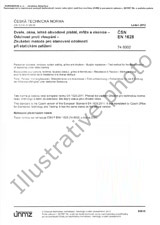We need your consent to use the individual data so that you can see information about your interests, among other things. Click "OK" to give your consent.
ČSN ETSI EN 303135-V2.1.1 (875168)
Electromagnetic compatibility and Radio spectrum Matters (ERM); Coastal Surveillance, Vessel Traffic Services and Harbour Radars (CS/VTS/HR); Harmonised Standard covering the essential requirements of article 3.2 of the Directive 2014/53/EU
Translate name
STANDARD published on 1.12.2016
The information about the standard:
Designation standards: ČSN ETSI EN 303135-V2.1.1
Classification mark: 875168
Catalog number: 500804
Publication date standards: 1.12.2016
SKU: NS-668744
The number of pages: 28
Approximate weight : 84 g (0.19 lbs)
Country: Czech technical standard
Category: Technical standards ČSN
The category - similar standards:
Annotation of standard text ČSN ETSI EN 303135-V2.1.1 (875168):
V2.1.1
The present document applies to X-band radar sensors intended for use in Vessel Traffic Services (VTS), Coastal Surveillance (CS) or Harbour Radar Systems with the following characteristics:
- " Utilizing modulated or unmodulated pulses.
- " Transmitter Peak Envelope Power up to 100 kW.
- " The transceiver-antenna connection is using a hollow metallic rectangular waveguide.
- " The antenna is rotating, waveguide- based and passive.
- " At the transceiver output an RF-circulator is used.
NOTE 1: Since transceiver and antenna are hollow metallic rectangular waveguide based, the frequency range for measurements that needs to be addressed covers 6,56 GHz to 26 GHz. The lower limit of this frequency range is obtained as cut-off frequency of the combination of WR112/R84 taper section and a WR90/R100 Waveguide as defined by IEC 60153-2 [i.2]. The upper limit corresponds to the upper limit stated in ERC/Recommendation 74 01 [i.4]. Other types of waveguide may be used by the same principles to obtain complete measurement coverage of the frequency range of the output flange of the equipment under test.
NOTE 2: Since at the transceiver output an RF circulator is used, it is assumed that the transceiver char-acteristics remain independent from the antenna.
NOTE 3: According to article 5 of the ITU Radio Regulations [i.5] there are a number of bands between 8,5 GHz and 10 GHz that are allocated to Radiolocation service. There are national deviations to the detailed band usages, but the basic spectrum usage regulation is the same.
The present document contains requirements to demonstrate that "...radio equipment shall be so constructed that it both effectively uses and supports the efficient use of radio spectrum in order to avoid harmful interference" [i.1].
In addition to the present document, other ENs that specify technical requirements in respect of essential re-quirements under other parts of article 3 of the Radio Equipment Directive [i.1] may apply to equipment within the scope of the present document
Preview of the standard ČSN ETSI EN 303135-V2.1.1 (875168)
We recommend:
Technical standards updating
Do you want to make sure you use only the valid technical standards?
We can offer you a solution which will provide you a monthly overview concerning the updating of standards which you use.
Would you like to know more? Look at this page.




 Cookies
Cookies
